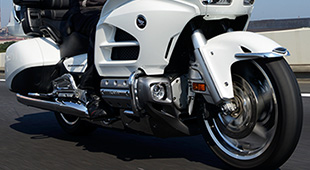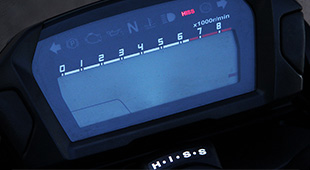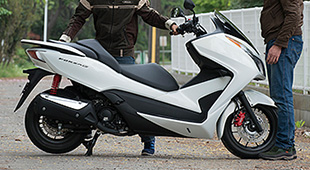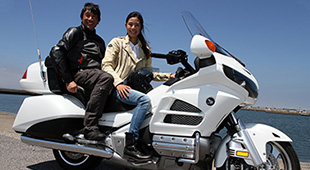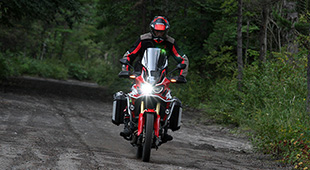Tech Views — Vol.8 CRF1000L Africa Twin
Technical Points
A big touring bike that enthusiastically takes up off-road riding.
The more one comes to know about the new Africa Twin, the more one can come to understand that it is a motorcycle featuring two 'exceptionalities.'
One is that it features superb off-road performance, although it is fundamentally a large-displacement touring bike, and the other is that it powered by a large-displacement engine in spite of it being an off-road bike.
Usually, off-road motorcycles become harder to control as their engine displacement increases, and comfortable touring bikes often require a certain increased degree of displacement and weight.
The Africa Twin was created with these points in mind.

Unlike the venerable V-twin engine that most people associate with the original Africa Twin, the new Africa Twin's engine features a compact parallel-twin configuration. To improve controllability and handling ease when riding off-road, the distance between the rider and the front wheel needed to be shortened. It is for this reason that the parallel-twin engine, which is shorter in longitudinal length than the V-twin, was selected. The adoption of the parallel-twin engine also offers additional merits in that it allows the center of gravity and mass of the engine to be positioned farther forward than is possible in the case of the V-twin, leading to an optimal front load distribution.
On the other hand, off-road riding requires the ability to freely change one's riding position, and so the rear end of the fuel tank where it integrates with the riding position and around the seat rails needs to be made as narrow as possible. Although the rear cylinder of a typical V-twin engine may be located between the rider's thighs when ridden, if a parallel-twin engine is used, that area can be put to more efficient use as a space for auxiliary equipment, etc. Because of this merit (i.e. the ability of providing more centralized mass by positioning the heaviest components, such as the battery, in that space), the parallel-twin configuration proved to be essential. For this reason, it can be said that Honda gave priority to the design of the engine without tying itself to the conventional image of the Africa Twin.
Furthermore, as nearly 15 years had passed since the original Africa Twin ended production, technologies that made great advances in the interim were also selected for use in the new model. These include an ABS version, not to mention standard-equipped HSTC (Honda Selectable Torque Control). Honda's advanced DCT (Dual Clutch Transmission) technology also proved to be effective for enhancing the off-road performance of this large-displacement touring bike.
The new Africa Twin is poised show us the brillant new world that lies beyond the door to Adventure.
Package
The new Africa Twin maintains essentially the same body size and weight as its predecessor, however power output has been increased by fully 1.5 times. It is also 43kg lighter in weight than the VFR1200X, and 13kg lighter than the VFR800X. Moreover, its 70kW power output is comparable to the 74kW put out by the CB1300 Series, enabling riders to fully enjoy its high power and torque, which rumbles up from deep down in its wide rev range, making the new Africa Twin a remarkably easy to control riding machine.
Furthermore, the Africa Twin also employs many technologies first introduced on the CRF450 Rally that recently competed in the Dakar Rally, such as an LED headlight that has proven to be highly effective for long touring, a multi-function meter and adjustable front and rear suspensions. These technologies combine with versions available with switch-selectable DCT and ABS to make the Africa Twin eminently suitable for a new era of motorcycling enjoyment.
Engine
The Africa Twin's newly-designed parallel-twin engine employs a SOHC Unicam valve train to actuate the 4 valves in each combustion chamber. The engine's compact configuration features an external design that doesn't feel as if it has a large 1,000cc displacement. Power output characteristics offer excellent response, while its 270-degree offset crankshaft contributes to the engine's enhanced torque and traction. Providing a pleasant pulsating feel, this engine offers excellent controllability, as if the throttle and rear tire were directly linked to each other. Further, as might be expected of a touring model, its engine provides strong torque from anywhere in its wide rev range, and features dual balancers for reduced primary vibration.

Handling
While the Africa Twin is a large-displacement touring model, its total weight does not exceed 232kg (standard type: 228kg). Its chassis configuration has been finished to provide good controllability in off-road riding. Additionally, both front and rear overhangs are kept to a minimum, and the battery and other heavy components have been centrally positioned in the area nearest the motorcycle's center of gravity for supremely agile handling.
Furthermore, the compact engine also makes possible a ground clearance height of 250mm, while also improving the Africa Twin's stellar off-road performance.
Turning Capability
The Africa Twin's 43 degree steering angle makes possible a minimum turning radius of 2.6m, which represents the top level in the adventure class. This feature also leads to improvements in turning ability not only when riding, but also when parking or moving the bike.
Two different seat heights (870mm and 850mm) can be selected by changing the seat's mounting position. Further, a high seat and a low seat are also made available as optional equipment, with the former enabling the seat height to be raised by 30mm and the latter to lower the seat height by 30mm. This extends the highest seating position to up to 900mm and the lowest position down to 820mm, thus making it possible to adjust the seating position to best match a wide range of rider sizes.
Bodywork
As one would expect from a world-leading adventure model, the new Africa Twin features heavy-duty construction with bodywork and engine designed to be effectively free of protrusions in order to minimize the potential for chassis damage. The goal of this design is minimizing injury and damage that might occur if the motorcycle should accidentally fall when traveling off-road, etc. Moreover, some versions will also be standard-equipped with a large aluminum skidplate mounted under the engine.
And by minimizing the number of body panel parts used in the pursuit of functional beauty, a body construction that minimizes damage was realized.
HSTC (Honda Selectable Torque Control) System
The new Africa Twin also comes standard-equipped with the Honda Selectable Torque Control System, which controls the engine's torque output by detecting differences in the slip ratio between front and rear wheels. When the rear tire loses traction on a slippery road surface, this system causes the control system to instantly kick in and suppress the torque generated by the engine by controlling fuel injection to inhibit rear tire slip. The amount of torque control can be selected in three steps, and the torque control system can also be disabled.
ABS-Equipped Version
The Africa Twin will also be made available in a version equipped with ABS (Antilock Brake System) and featuring mode switching capability. Called 'Adaptive Rear ABS Cancelling,' this system disables the ABS at the rear wheel when set to the OFF position. This feature contributes to off-road riding ease by allowing separate use of the front and rear brakes, allowing the machine to be controlled by only the rider's operation.

DCT-Equipped Version
For the first time ever in an off-road model, the Africa Twin will also be made available in a version equipped with Honda's innovative DCT (Dual Clutch Transmission) motorcycle technology. The system features both a Manual mode and two different automatic gear change modes: 'D' mode enables comfortable cruising and low fuel consumption, while 'S' mode offers a more sporty gear shift patterns (adjustable in 3 steps).
The system has also been equipped with a new 'G Switch' that allows the Africa Twin to control clutch application and power fluctuations at low revs, depending on riding conditions, for a perceptible increase in tractable power. Turning off the switch makes the power delivery more gentle, bringing an extra level of stability to the machine's behavior.
The Africa Twin's DCT was designed with the assumption that off-road riders needing to concentrate on the road or terrain ahead, not to mention their own body control, would greatly benefit from being relieved of the distraction of gear changes, making it possible to more fully enjoy the experience of off-road riding.
- Top
- History
- A New Era
- Technical Points
- Development Story

